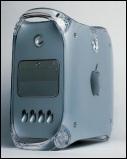|

Inside
the magazine
Self-help message board
Article reprints
How to contact us
Web links directory
Software downloads
Tips and advice
Fire-wire campaign
Subscribe today
Help Me, I'm new!
Fair pricing petition
Home

In
Software Downloads:
Adobe
Premiere 6 (trial)
Paint Shop Pro 7 (trial)
Tips
and Advice:
How to get started with
computer video editing
Fire-wire
Campaign:
Join our ongoing campaign
|
Apple dual-1.25GHz
PowerMac
 Apple
has now boosted the speed of processors in its G4 PowerMacs, and switched
exclusively to twin-processors. We check out the dual-1.25GHz model
with 512MByte RAM and a SuperDrive DVD writer. Apple
has now boosted the speed of processors in its G4 PowerMacs, and switched
exclusively to twin-processors. We check out the dual-1.25GHz model
with 512MByte RAM and a SuperDrive DVD writer.
In the summer, we
looked at Apple's G4 Power Mac, fitted with two 1GHz G4 processors,
and tested it against a Windows dual-Athlon XP2000 PC.
The Mac scored well in design and features, but proved to be relatively
slow in a number of comparative tests. Apple has now introduced a pair
of dual-1.25GHz Power Macs to top the range, and it's the cheaper of
the two - still costing £200 more than the dual-1GHz - that we're
looking at here.
All of Apple's current computers boot into OS 10.2 - or Jaguar, as it's
also called - rather than the 10.1.4 version installed on the dual-1GHz
model we tested previously. New Macs can also be booted in OS 9.2.2
for running programs that don't work under OS X 10.2 - such as Quark
Xpress. OS X can also run a copy of OS 9 in a window within its interface,
but this is wasteful of RAM and doesn't always deliver the same performance
as a real OS 9 system.
Jaguar OS X 10.2 - which took just 25 seconds to boot up on the new
Mac - is said to enhance the multi-tasking performance of processors,
thanks to its use of QuickTime 6, and is also reckoned to offer improved
2D, 3D, text and video on-screen, courtesy of its Acrobat-based hardware-accelerated
graphics compositing technology, Quartz Extreme.
As all new Macs bought after January 2003 will only be able to boot
in OS X 10.2 - unless users do a complete manual install of OS 9 themselves
- we were keen to see what effects (if any) the latest operating system,
combined with the faster processors, had on dual-processor-optimised
video editing.
Style power
The new-generation Power Macs - which also take in dual-processor
867MHz and 1GHz versions - are similar in design to the previous generation,
but have a number of new features largely to improve cooling.
The front now has four vents at the bottom, and a central silver panel
conceals the two 5.25in drive bays - one occupied by a DVD-R SuperDrive
(Pioneer DVR-A04 burner), and the other free. The speaker now sits higher
up, and is less likely to be obscured by desktop clutter.
The rear panel is almost completely taken up with small vent holes,
and port positions are altered slightly due to the use of a new motherboard.
The ports - two FireWire (IEEE 1394), two USB 1.1, Gigabit Ethernet,
56k modem, Apple speaker, and audio line in/out (16-bit stereo) - are
now below the four 64-bit, 33MHz PCI slots (all free in this configuration)
and AGP graphics card connector. Inside, the motherboard is dominated
by an enormous heat sink mounted on the two processors.
Huff and puff
We were pleased to note that, when up and running in OS X, the dual-1.25GHz
machine is only marginally noisier than older Power Macs. However, the
noise from the two system fans (there are four in total) increases considerably
when running OS 9. Worse still, after rebooting or waking up, this can
suddenly turn into a deafening roar ñ the like of which weíve
never heard on any modern computer. The fans are intended to change
speed according to processor usage, but clearly there must be something
wrong with the monitoring process. Noise can be a major problem when
editing the audio side of a video production ñ and just plain
irritating otherwise ñ so this is a serious matter and needs
addressing.
Conclusion
We couldn't make many precise comparisons between the two dual-processor
Macs, because system hardware and operating systems were different and
the previous reviewer's content files weren't available. Nonetheless,
our tests again show that processor speed is only one factor in the
performance equation even though greater speed does improve workflow
for the video editor.
One serious downside to the new 1.25GHz machine is the noise - this
needs to be sorted out urgently. More worrying still was the tendency
for the latest versions of Apple's own professional editing program
Final Cut Pro 3.0.2 to quit without warning when running under OS 10.2.
This is more than an annoyance - it undermines the credibility that
Apple has worked so hard to achieve for FCP.
The company also needs to urgently address incompatibility issues between
DVD Studio Pro and QuickTime Pro 6, so that users are not forced to
downgrade to QT Pro 5 if they wish to create their projects on DVD under
OS X 10.2.
What we did find encouraging was how successful a third-party software
developer - Adobe - has been in creating an OS X-compatible version
of its competing video editing program, Premiere.
We also have to say that we were hugely impressed by the on-screen image
reproduction of the new Mac, which we have to credit to OS 10.2ís
new Quartz Extreme technology.
In truth, though, there is little point in flashy pictures and faster
processors if the Mac's default boot operating system isn't able to
work in harmony with Apple's own applications, and if users can hardly
hear themselves above the din made by the machine. This situation is
certain to produce headaches for users, and likely for Apple, too.
Lisa Keddie
Read the full
review in January 2003's Computer Video magazine.
|
Recent features...
View
The Archive
Reviewed in January's issue:
Avid
XpressDV 3.5 Power Pack
Apple dual-1.25GHz PowerMac
Pinnacle Pro-ONE RTDV
In January's news:
Sony
doubles DVD options
Mitsubishi media problem
Stills on steroids
Apple goes native
Pinnacle Studio 8 bundle for the laptop
Microsoft to replace Movie Maker
Pinnacle budget DVD authoring
High-speed Pioneer DVD
Planet Birkenshaw
Royalty-free backgrounds
Roxio Easy CD Creator update fixes Win XP bugs
Windows Media Player 9 enhancements
|





 Apple
has now boosted the speed of processors in its G4 PowerMacs, and switched
exclusively to twin-processors. We check out the dual-1.25GHz model
with 512MByte RAM and a SuperDrive DVD writer.
Apple
has now boosted the speed of processors in its G4 PowerMacs, and switched
exclusively to twin-processors. We check out the dual-1.25GHz model
with 512MByte RAM and a SuperDrive DVD writer.